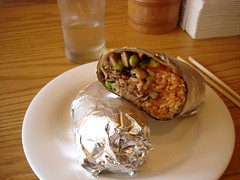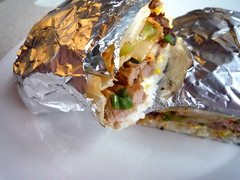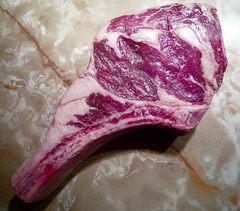New Ways to Boost Your Grain Power 2: Congee!
 fig. a: Danny hearts Chinatown
fig. a: Danny hearts Chinatown
There were numerous things to like about Lucky Peach's special on "Chinatown"(#5, Fall 2012)--it's an issue of the magazine that we've gone back to repeatedly, and every time we seem to find something new hiding within. But probably our favourite feature was the one on Danny Bowien and his love affair with Chinese food. This might seem self-evident for a story about the chef of Mission Chinese Food NYC appearing in an issue on Chinese-American foodways, but Bowien is Korean-American and he grew up in Oklahoma, and the impression you get from the article is that New York's Chinatown continues to be a source of complete wonderment. As Chris Ying puts it in the foreword:
On his days off from cooking Chinese food at Mission Chinese Food, Danny eats Chinese food. Whenever I come to New York, he immediately brings me to Chinatown to show me what new gem he's unearthed.The article features some typically tripped-out Mission Chinese-style Chinese-American fare, like Bowien's "Chinese McDonald's" spread, consisting of pigtail nuggets with seaweed fries and three dipping sauces (sweet & sour, General Tso, and spicy mustard), but we were most attracted to the more traditional recipes that bookend it. (After all, the title of the article is "Cooking What Chinese People Eat: Recipes by Danny Bowien.") And we were especially attracted to the recipe for rice porridge, a.k.a. congee, that kicks off the article.
Montreal isn't much of a congee town. At least it's not enough of one to support a large congee-centric enterprise such as a Congee Palace, Congee Village, Congee Garden, or a Congee Queen (or a Palais Gruau, Village Gruau, Jardin de Gruau, or a La Reine du Gruau, for that matter). And, frankly, neither of us could claim to be too well-versed in the pleasures of congee--we'd only had disappointing experiences in the past. But there was something about the purity and the simplicity of this recipe, something about the ingenious technique behind it, that intrigued us. Plus, we'd prepared and eaten countless Asian breakfasts of all stripes over the years, but we still didn't know a whole lot about Chinese breakfast, aside from dim sum and cold leftovers out of the takeout containers, and Bowien made a pretty good case for it:
...there's no more fundamental Chinatown breakfast dish than rice porridge. It's total stick-to-your-ribs stuff that'll keep you full the whole day. It's quick and cheap, and couldn't be simpler to make.As an additional bonus, the recipe involved toasting the rice, which made it ideal for this series. So a few weeks ago, we went to our local butcher to pick up an organic chicken, we measured some jasmine rice, we opened up our issue of Lucky Peach, and we got to work.

 fig. b & c: preparing the bird
fig. b & c: preparing the birdRice Porridge, a.k.a. Congee
1 whole chicken, preferably with head and feet
1 celery stalk
1 carrot
2 cups white rice
8 qts water
cheesecloth
2 chopsticks
toppings of your choice (such as toasted sesame seeds, chopped cilantro, egg yolks, salmon roe, smoked eel, sea urchin, etc.)
Salt the chicken heavily inside and outside the cavity. Make sure you rub salt under the wings. Stuff the cavity with the carrot and celery stalk. Refrigerate overnight.
Bundle the chicken in a large piece of cheesecloth and tie it off. The cheesecloth needs to be big enough that you'll be able to tie the excess cloth to the side of a stockpot in a knot.
Toast the rice in a dry stockpot over medium heat. Don't rinse the rice first. Here, you want the starches on the surface of the rice to thicken the porridge. Also, be careful not to burn the rice. Stir constantly until it is lightly toasted and aromatic--just a few minutes.
Add the water and bring to a boil over medium heat. Starting with cold water and boiling over medium heat (as opposed to high heat) will yield a lighter, cleaner soup.
Once the porridge boils (be patient, this will take a while), lower the chicken in and tie the cheesecloth to the handle of the pot, so the bird doesn't sit on the bottom and burn.
 fig. d: venting the pot
fig. d: venting the potVent the pot with a pair of chopsticks by balancing the chopsticks on opposite ends of the pot. Point one toward you, and the other away from you, then rest the lid on the chopsticks. (Bowien notes: "My cooks used to burn this porridge because they thought they knew a better way to vent the pot, but this is the way grandmothers do it. Trust me." We note: this method works perfectly. It both vents the pot and catches the condensation. The result is an ideal cooking temperature and maximum flavour.)
Cook at medium heat for 45 minutes to an hour. The rice should be very soft but not completely exploded into mush. Pull the chicken out and shock it in ice water. Once it's cooled, you can slide it and use it as a garnish or any other application that calls for a nicely poached chicken. Because that's exactly what you get: a nicely poached chicken with hints of rice flavour.
Season with fish sauce and salt. Bowien suggests: "Garnish with chopped cilantro, sesame seeds, an egg yolk, and your choice of toppings--smoked eel, ikura, uni, whatever."
 fig. e: Danny Bowien's rice porridge
fig. e: Danny Bowien's rice porridgeBowien claims that this recipe produces "4-6 servings," but, in fact, it makes enough for at least 12.
 fig. f: we heart leeks
fig. f: we heart leeksWe followed his advice to a point, but instead of going the seafood route, we went the pork and vegetables route. Specifically, I made some sweet & sour Chinese-style ribs, and Michelle sautéed some leeks, as well as some baby bok choy. Why? Well, we were pretty sure it would taste great. Plus, there must have been something about Bowien's description of rice porridge as "total stick-to-your-ribs stuff" that struck a chord. And, finally, we had a feeling that sweet & sour caramel would be a pretty nice thing to drizzle over the congee as a finishing touch. We were right.
The result is the very definition of comfort food, as delicate, satisfying, and warming a variation on chicken soup as you're likely to find. The texture is somewhere between risotto and cream of wheat, if that makes any sense. It may be "total stick-to-your-ribs stuff," but it's definitely not stodgy. And it's also another great way to increase your grain power.
aj















